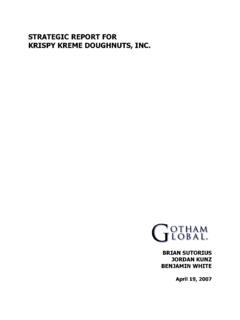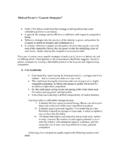Transcription of STRATEGIC REPORT FOR PFIZER PHARMACEUTICAL …
1 STRATEGIC REPORT FOR PFIZER PHARMACEUTICAL COMPANY COREY VAN DER WAL ELIHU BOGAN ADAM HENRY April 18, 2007 2 TTAABBLLEE OOFF CCOONNTTEENNTTSS EEXXEECCUUTTIIVVEE 33 CCOOMMPPAANNYY 44 CCOOMMPPEETTIITTIIVVEE 55 IINNTTEERRNNAALL 66 BBAARRRRIIEERRSS TTOO EENNTTRRYY AANNDD EEXXIITT .. 77 SSUUBBSSTTIITTUUTTEESS AANNDD 88 SSUUPPPPLLIIEERR 99 BBUUYYEERR 99 FFIIVVEE FFOORRCCEESS 1100 FFIINNAANNCCIIAALL 1100 AATT AA 1100 SSTTOOCCKK 1111 DDUUPPOONNTT AANNAALLYYSSIISS .. 1122 DDIISSCCOOUUNNTTEEDD CCAASSHH FFLLOOWW 1133 SSWWOOTT 1144 SSTTRRAATTEEGGIICC 1155 IISSSSUUEE ## 1155 IISSSSUUEE ##22 .. 1177 1188 RREECCOOMMMMEENNDDAATTIIOONN 1199 RREECCOOMMMMEENNDDAATTIIOONN 22 .. 2222 RREECCOOMMMMEENNDDAATTIIOONN 2233 RREECCOOMMMMEENNDDAATTIIOONN 2255 HHOOWW RREECCOOMMMMEENNDDAATTIIOONNSS AALLLLEEVVIIAATTEE 2266 2299 3 EEXXEECCUUTTIIVVEE SSUUMMMMAARRYY PFIZER (Ticker Symbol: PFE) is the world s largest research-based PHARMACEUTICAL company with a market capitalization approaching 200 billion USD.
2 The Company produces drugs which address nearly every kind of human and animal ailment imaginable. PFIZER researches, develops, produces, markets and sells its products. The Company divides its product line into three distinct groups: human health, consumer healthcare and animal health. The top products by revenue and volume produced by the human health group include Lipitor (for cholesterol), Norvasc (for hypertension and angina), Zoloft (for depression), Celebrex (for arthritis) and Viagra (for erectile dysfunction). Lipitor is the world s highest revenue-generating prescription medicine. The consumer healthcare segment makes such common over-the-counter medications as Listerine, Nicorette, Benadryl, Sudafed, Visine, Purell and BenGay. The animal health division produces various products including parasiticides, anti-inflammatories, vaccines and antibiotics.
3 PFIZER s human health group accounts for the lion s share of the Company s revenues (93% in 2006). PFIZER is a truly international company. While the Company is based in New York City and earned of its fiscal 2006 revenues1 in the , the Company has 79 plants and locations spread across the globe2. The Company s major facilities outside of the are in Belgium, Brazil, France, Germany, Ireland, Italy, Japan, Mexico, Puerto Rico, Singapore, Sweden and the UK. This paper reviews PFIZER s history, examines the forces at play in the PHARMACEUTICAL industry as a whole and provides a high level financial analysis of the Company. This REPORT uses these three areas of research to identify two major STRATEGIC issues facing PFIZER today and recommends four solutions PFIZER can implement to meet these challenges.
4 1 PFIZER 2006 10-K Financial REPORT 2 Ibid 4 CCOOMMPPAANNYY BBAACCKKGGRROOUUNNDD Today s global behemoth PFIZER finds its modest beginnings in a brick building in Brooklyn, New York in 1849. Using $2,500 borrowed from his father, Charles PFIZER founded Charles PFIZER & Co. with his cousin Charles Erhart. The cousins were young entrepreneurs from Germany who wanted to bring chemicals not found in the US to the American marketplace. The first product the Company made was a candy cone, created by combining Santonin (an anthelmintic, or agent that is destructive to worms and is used for removing internal parasitic worms in animals and humans) with almond-toffee flavoring. The tasty remedy was an immediate success and the nascent company was up and running.
5 In 1857, the Company bought 72 acres surrounding its original Brooklyn building and established an office in Manhattan in what is today the heart of New York s drug and chemical district. The American Civil War was a great boon to PFIZER as it greatly expanded production to meet the need of Union soldiers for a plethora of painkillers, preservatives and disinfectants. Spurred by the demands of the War, PFIZER s revenue doubled between 1860 and 1868. Citric acid (a colorless translucent crystalline acid principally derived by fermentation of carbohydrates or from lemon, lime, and pineapple juices) was a key product for PFIZER from 1880 well into the 20th century, a period of time in which it became America s leading producer of citric acid. Citric acid is used in soda and magnesia (a popular laxative).
6 As the use of soda became engrained in American culture, PFIZER looked for a way to meet the ever-growing demand and was the first to produce citric acid in bulk. This success led to great growth for PFIZER and the Company added an office in Chicago, Illinois in 1882. In 1891, Charles Erhart died and Charles PFIZER bought his cousin s portion of the Company for $250,000, concentrating ownership of the blossoming company. The 1900 s were defined by multiple races to be the market leader in the discovery and production of a number of life-changing drugs. PFIZER led the market in Vitamin C and Penicillin and many others PHARMACEUTICAL products. 5 Taking a cue from the development of Penicillin, PFIZER scientists began to research ways of creating more types of antibiotics.
7 The drug Terramycin, a broad-spectrum antibiotic first produced by PFIZER in 1950, was the first drug to be created solely by PFIZER scientists. Recognizing the business value of owning a drug patent rather than licensing it from others, PFIZER sold the rights to Terramycin to itself. Finding this approach profitable, PFIZER shifted more focus into research. On June 22, 1942, 250,000 common shares of PFIZER were sold in the Company s initial public offering. Soon following this, PFIZER made a major international push, opening operations in Belgium, Brazil, Canada, Cuba, England, Mexico, Panama, and Puerto Rico. In order to augment this international growth, PFIZER acquired a number of companies. Partially due to these acquisitions and partially due to the continued discovery and production of new drugs, PFIZER crossed the billion dollar sales threshold in 1972.
8 Explosive growth has continued since 1972 by emphasizing the strategy of the research-based model. Today, PFIZER revenues are about $48 billion annually and the Company produces many of the world s leading drugs and consumer products. CCOOMMPPEETTIITTIIVVEE AANNAALLYYSSIISS PFIZER is classified as SIC Industry 2834, PHARMACEUTICAL Preparations. Other corporations in this industry include Johnson & Johnson, Merck, Novartis and GlaxoSmithKline. The very technical criteria of the patenting process allows companies to produce similar, but not identical, drugs to address the same condition. Therefore, these companies are in the most direct competition when researching these products rather than in producing and selling these products. The following review of Porter s five Forces provides a summary this phenomenon as well as other key drivers of the PHARMACEUTICAL industry.
9 6 IINNTTEERRNNAALL RRIIVVAALLRRYY The PHARMACEUTICAL preparations industry is characterized by intense competition and a constant battle for the next blockbuster drug. Discovering a blockbuster drug can mean billions of dollars in revenues for the discoverer and/or patent owner. This is a winner-takes-all patent race. Not only is the company which creates and patents the new hot drug ( Lipitor) guaranteed a steady and solid revenue stream for the life of the patent, but by beating out its competition it has left them with research and design costs without any offsetting revenue. Drug creation is only half of the story. PFIZER and the other large firms in the industry distinguish themselves from their competitors not only by their ability to engineer new blockbuster drugs, but also by mass producing and selling large quantities of their various products.
10 The successful firms in the industry possess large sales forces enabling them to aggressively bring their drugs to the market, whether it be prescribing physicians or store shelves, whereas less well-healed drug companies which have significantly smaller sales forces with fewer resources are typically slower to bring their products to market. For the first time in recent history, however, the smaller firms have a real chance at competing head-to-head with the larger drug companies like PFIZER because the future of the industry lies in personalized drugs based on individuals DNA. Such products are quite specialized, and thus the introduction of these drugs opens the door for more market niches to fill. As a result, the industry is sure to see more small drug companies entering the market with their specific drugs, rivaling PFIZER and the other large firms with their ability to cater to much smaller, individualized markets.





